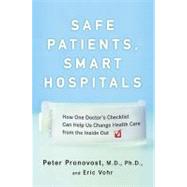
The New copy of this book will include any supplemental materials advertised. Please check the title of the book to determine if it should include any access cards, study guides, lab manuals, CDs, etc.
The Used, Rental and eBook copies of this book are not guaranteed to include any supplemental materials. Typically, only the book itself is included. This is true even if the title states it includes any access cards, study guides, lab manuals, CDs, etc.
Excerpted from SAFE PATIENTS, SMART HOSPITALS: How One Doctor’s Checklist Can Help Us Change Health Card From the Inside Out by Peter Pronovost, M.D., Ph. D, and Eric Vohr, publishing February 18th, 2010.
Chapter 3
We use checklists to standardize and ensure quality, consistency and safety every day of our lives. Even something as ubiquitous as our morning cup of coffee comes with its own checklist. I found this one on the Starbucks Website:
As simple as this sounds, coffee is complex -- nowhere near as complex as the human body, but nonetheless complex. One could easily write a 300-page book on how to best transform this scrubby little plant into a delicious, warm, eye-opening beverage. Roast, altitude, soil, sunlight and rainfall, all have effect on the flavor. However, according to Starbucks, when I wake up and prepare my morning fix all I have to worry about are the “four fundamentals,” proportion, grind, water and freshness -- a checklist, if you will.
Successful companies, like Starbucks, have been using checklists for years to ensure quality. Important processes are standardized and consistently performed whether in Baltimore or Beijing. Yet standardization is sorely lacking in health care.
Look at a something as obvious as hand washing. It’s been known in medicine for more than a century that this simple procedure can reduce infections and save lives. Yet doctors do not wash their hands consistently when visiting a patient and there is no standardized procedure in place to ensure they do. They know they are supposed to, but on average they do it 30 percent of the time. Perhaps more alarming, most hospitals do not monitor rates of hand washing and there’s no accountability for this performance. And while people don’t usually die from bad coffee, many patients have likely died from bacteria on a physician’s hands.
Why isn’t hand washing standardized in hospitals – along with thousands of other procedures that are known to save lives? It would be easy to blame doctors, but the bulk of the problem does not lie there. Most physicians care deeply about their work and want nothing but the safest care for their patients. It’s the culture of medicine and the systems within which doctors practice that are at fault. Physicians, including myself, are trained to believe that we don’t need standardization because we don’t make mistakes; we are told that our brains have endless storage capacity and that we have perfect recall of all the thousands of hours of information we’ve learned from medical school and years of practice. Yet we do not. The fact is, just like all other humans, we forget. We are fallible. We do not see systems and we are not trained to improve them.
Furthermore, doctors are also trained to believe that we don’t always have to follow the rules or ask for anyone’s help. We are the smartest people in the world and can figure out any problem on our own. When I was in medical school, I remember specifically being told, “Guidelines are for simple physicians not Hopkins physicians. At Hopkins we know the evidence, we are expert clinicians; we know the nuances of our patients so we do not need guidelines.” I have since realized how dangerous it is to use that statement to train physicians.
It’s true every patient is unique and clear guidelines are often absent or incomplete, making it necessary for doctors to rely on professional judgment to make personal, often independent, decisions about care. When evidence is immature or lacking, our intuition or reasoning is often the best evidence we have. However, we also need to recognize that standardization offers tremendous benefits, especially when evidence is robust. As medical science matures, we must progress from providing care primarily based on intuition, to a place where this independent approach is properly balanced with care based on collective wisdom and proven scientific evidence.
Yet as science continues to propel us into the future at an alarming rate, the culture of medicine dwells solemnly in the past. We do not train clinicians about the value of standardization, we do not train physicians to share knowledge or to improve bad systems that harm patients, we do not train physicians to work as a team organized around the patient and for the most part we do not hold them accountable for their performance or patient outcomes.